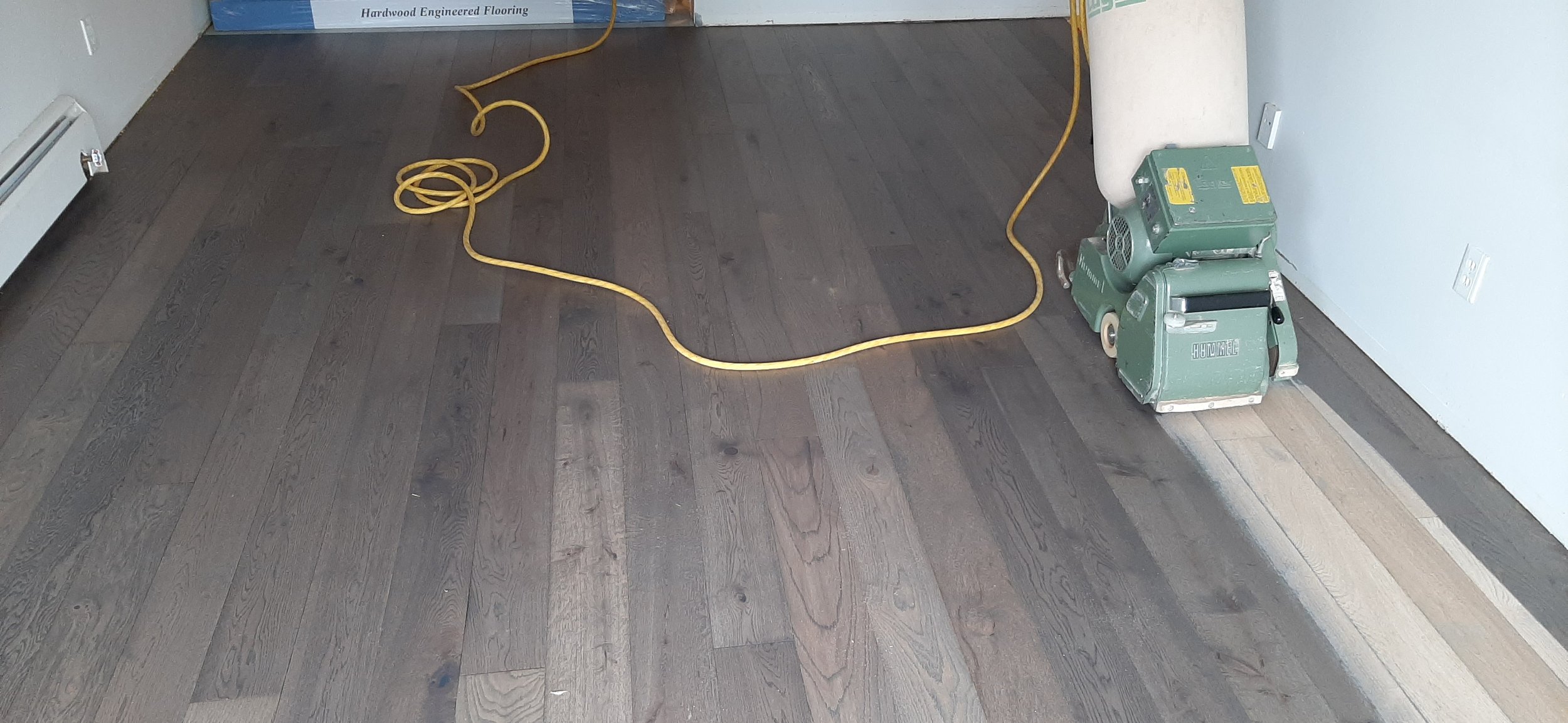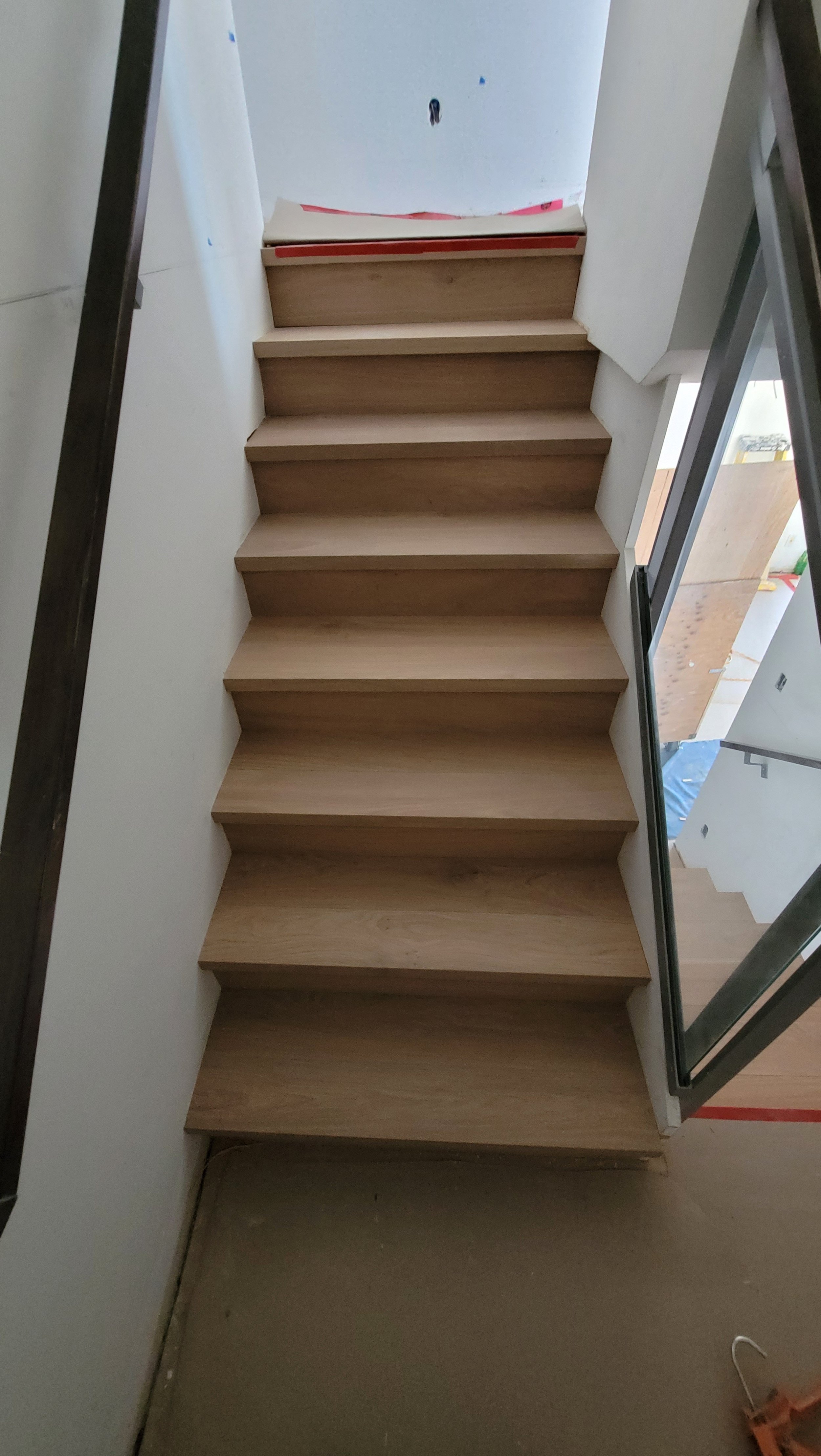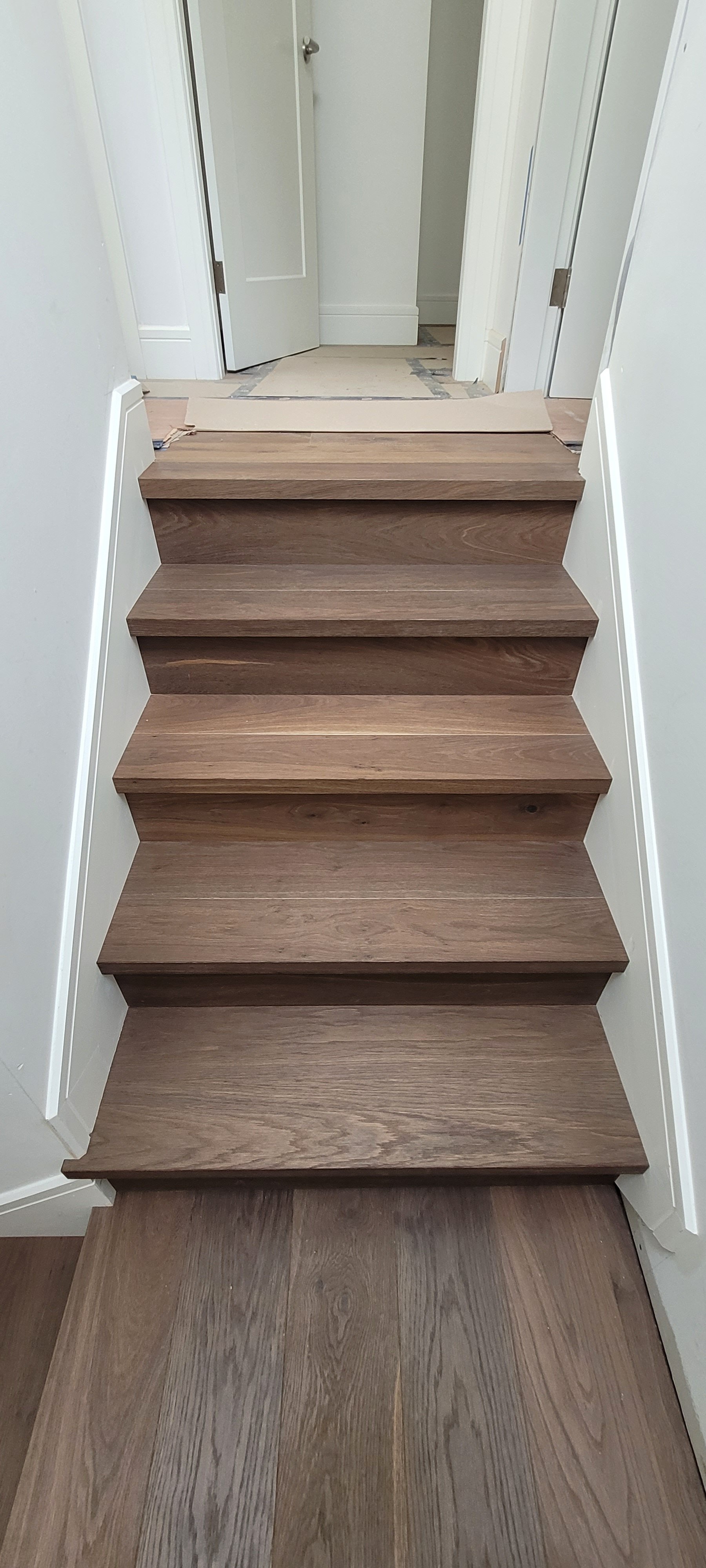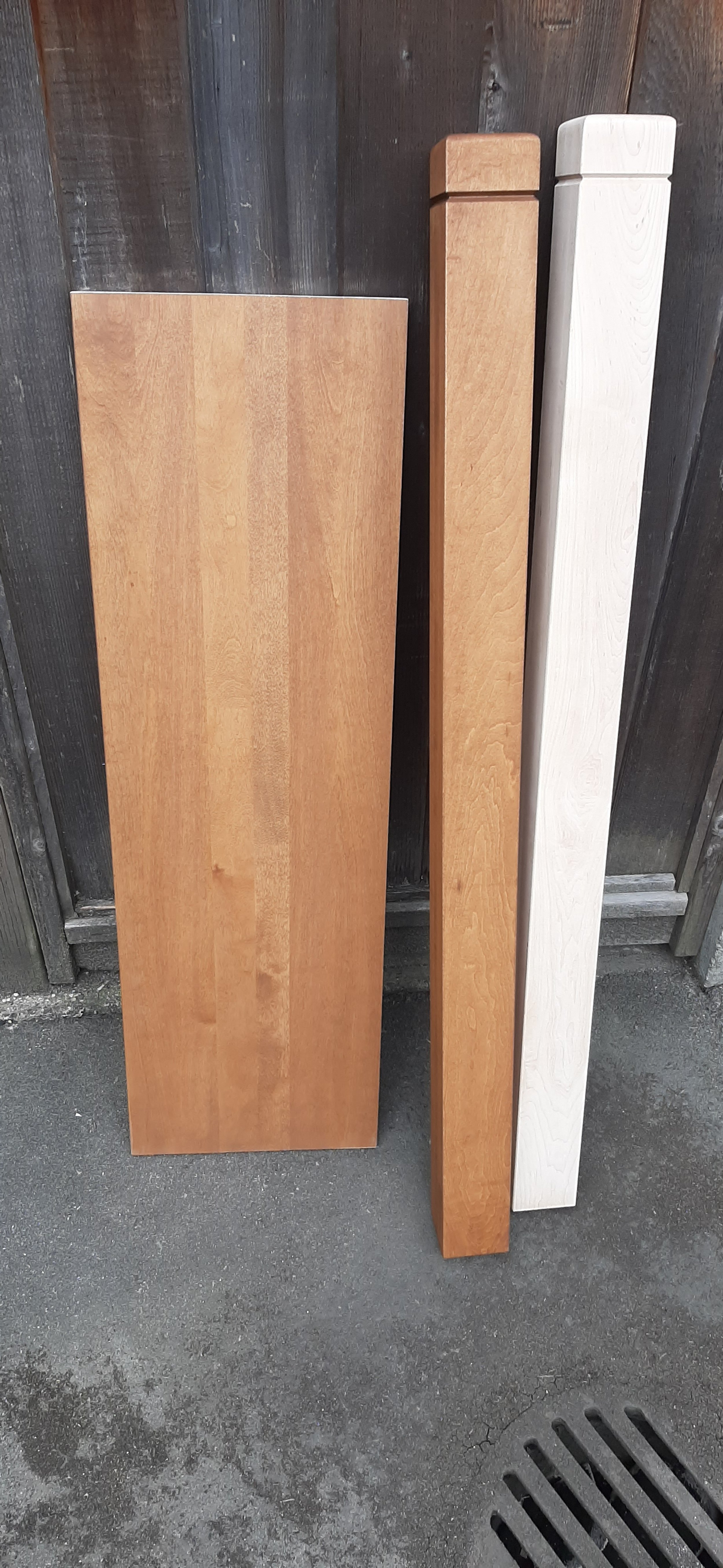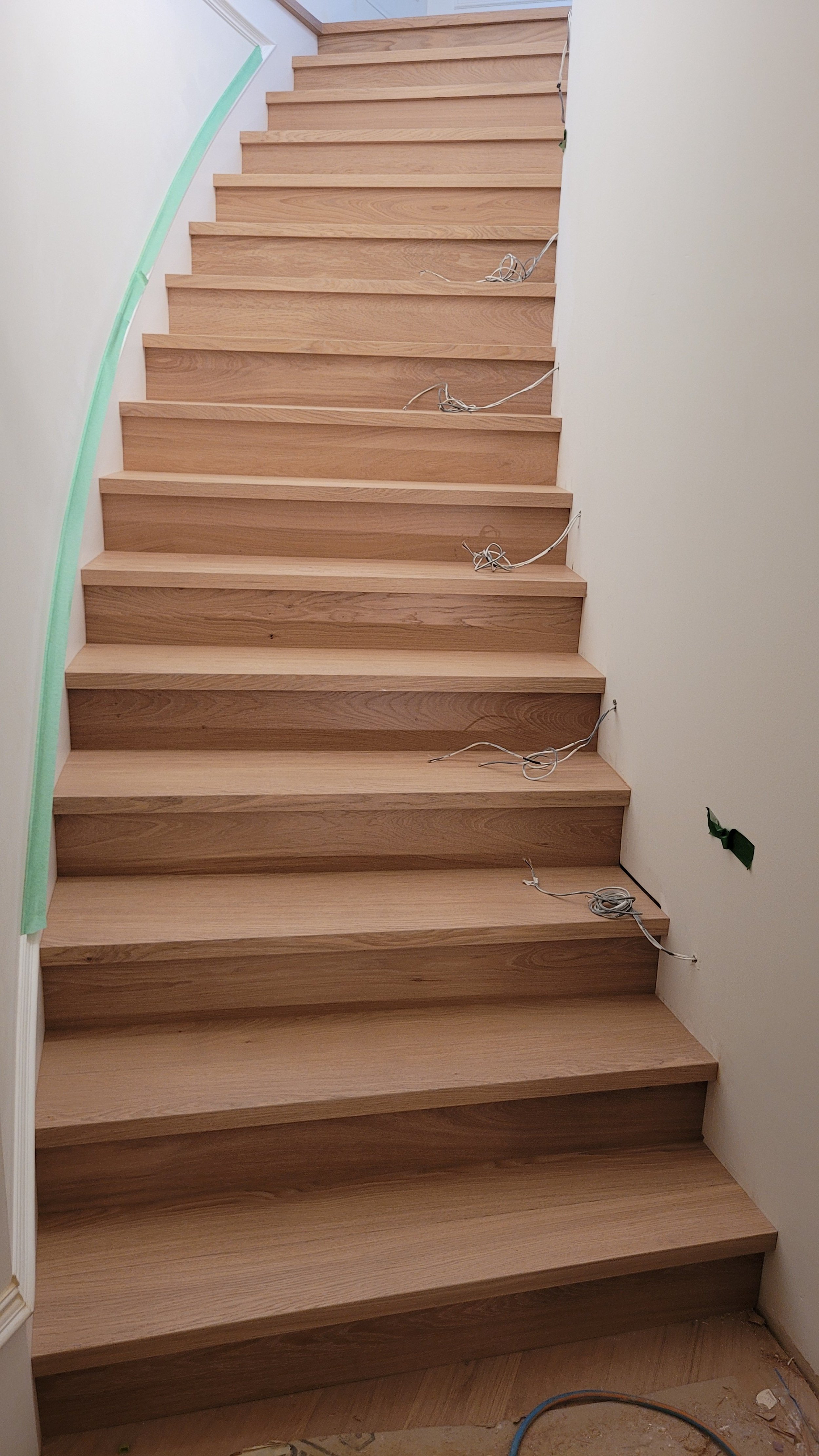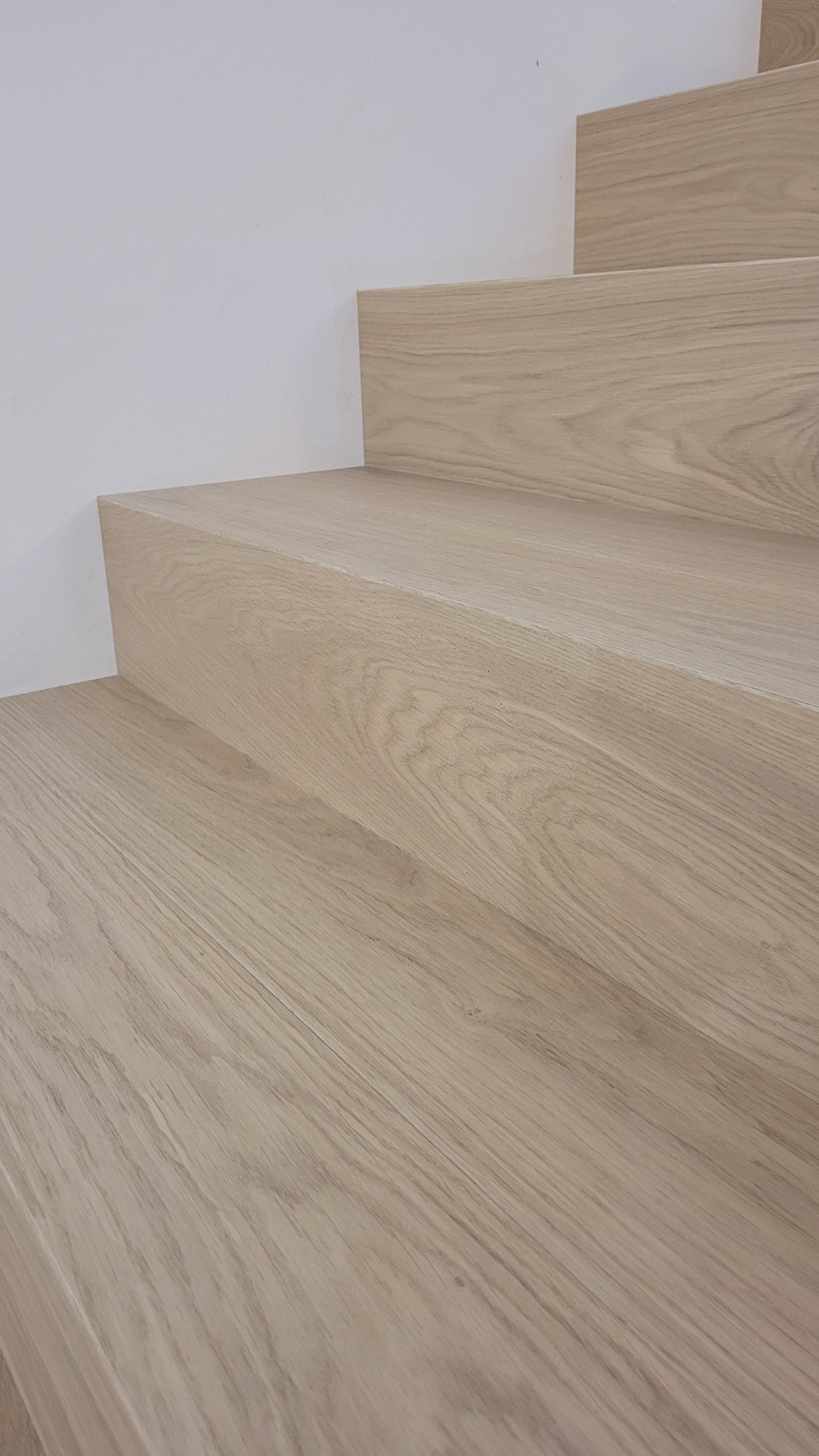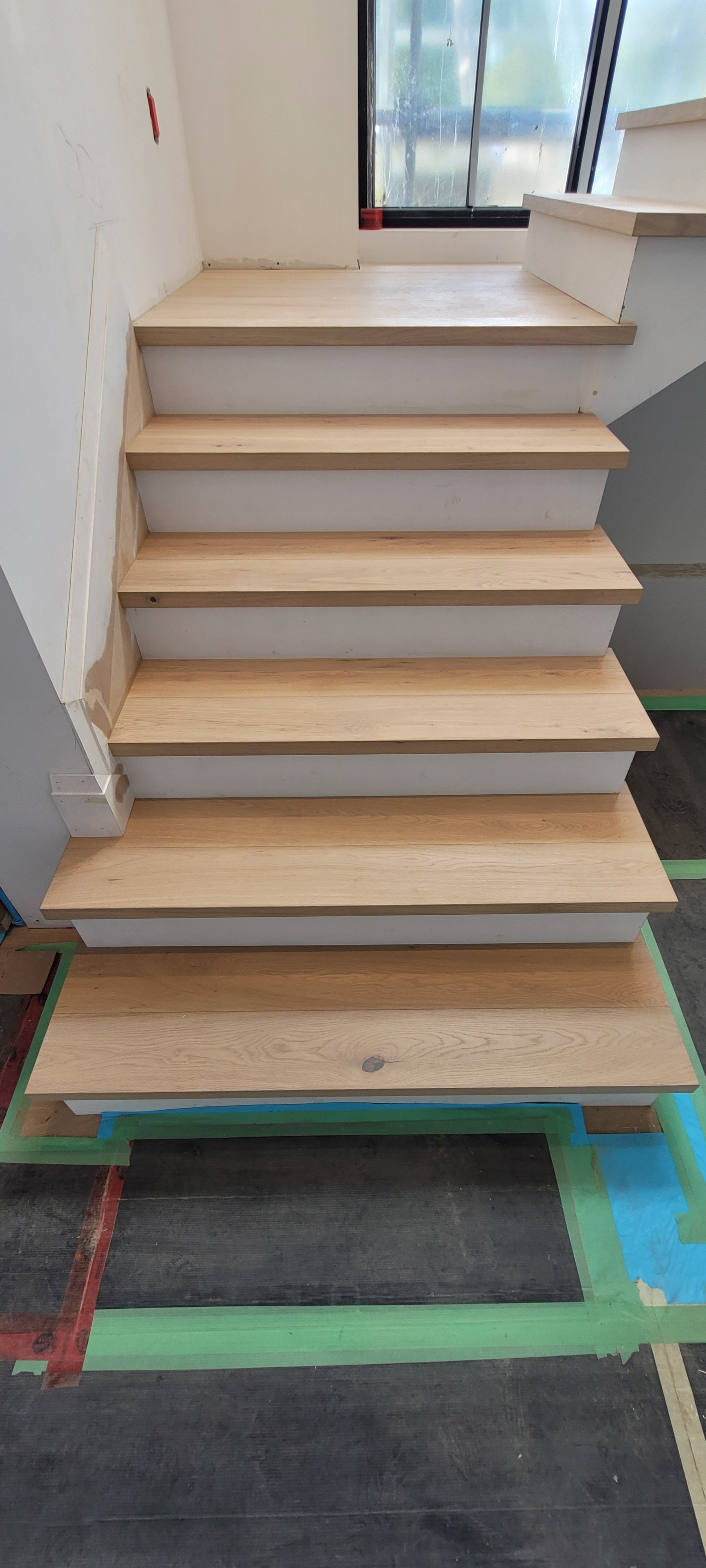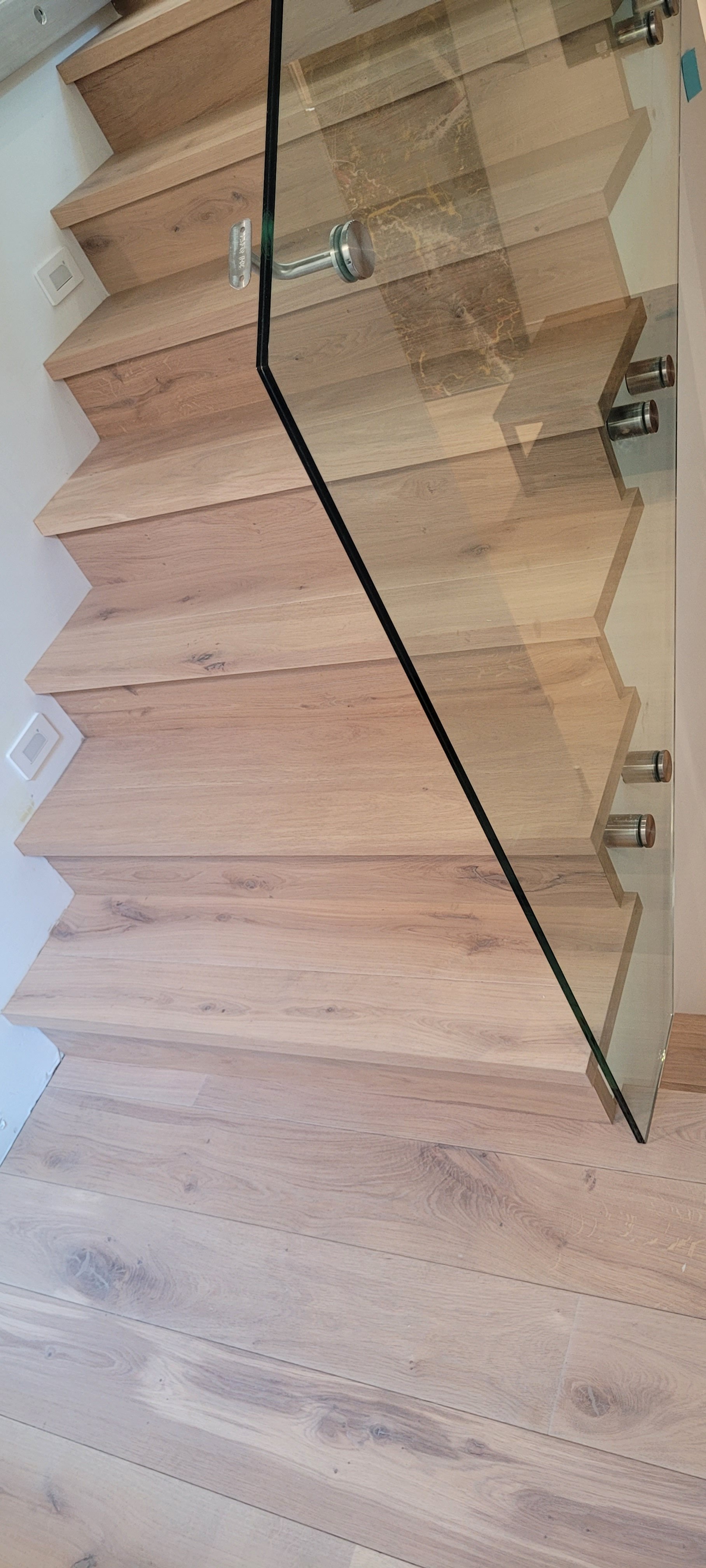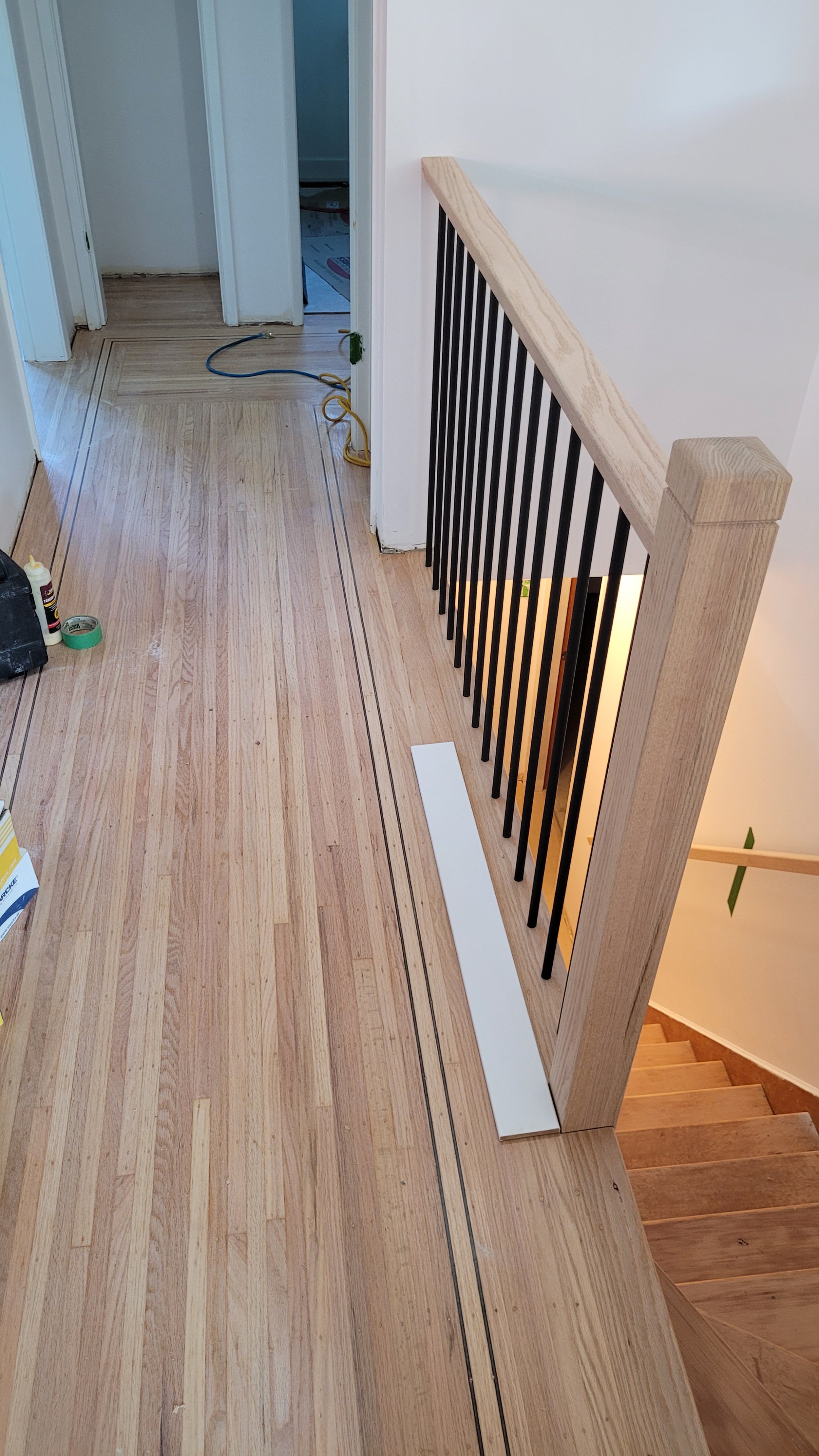Frequently Asked Questions About Your Hardwood Floors and Stairs
Can you help me identify my hardwood floors?
Most hardwood or softwood floors in the Vancouver area are red oak, white oak, maple, Douglas-fir (also known as just fir), walnut, or jatoba (also known as Brazilian cherry). It can sometimes be difficult to tell the difference between red oak and white oak. You can send Alex a message and chances are that he will be able to tell you! Here are some photos of various floors (click on images to open up a larger version):
Can you match my stairs and railings to my hardwood floors?
Yes! Your stairs can be built out of the same material as your hardwood floors. We can build both engineered hardwood stair treads and risers, as well as solid hardwood stair treads, risers and railings. Alex has been practicing color matching for over 15 years, so feel free to call and inquire about the color matching process. See below for a few examples of hardwood stairs being built out of hardwood flooring material, as well as posts and railings being color matched to stairs and floors.
Can my hardwood floors be refinished?
Send Alex photos of your floors through WhatsApp, e-mail or text message and he might be able to tell if your hardwood floors and stairs can be sanded and refinished. There are certain signs to look out for in assessing if your hardwood floors can be sanded. The biggest tell of all are large splintered edges running up and down your floor boards. If you see this, along with nail cleats, this may be a sign that they’re past their useable life. Not to be confused with top-nailed floors. These always show nail heads throughout the floor.
This fir hardwood floor in Gastown, Vancouver was sanded too heavily, down to the tongue and groove. Note the split and splintered edges along the boards, and heavy sanding marks. This floor could be repaired by carefully removing the top layer and inlaying a new, thicker, top wear layer. However due to there being damage throughout the entire space, it wouldn’t be economical to repair these.
Can you refinish my engineered hardwood floors?
Many engineered hardwood floors can be refinished. Engineered hardwood is not to be confused with laminate, LVT, or vinyl flooring. The top layer of your engineered hardwood floors is real hardwood. The plywood base of the boards are what makes them engineered. If the top layer is thick enough, the floors can be sanded and refinished.
Bleached Oak Railing
This oak railings was bleached and stained white to match an oak herringbone floor.
Can we get the red out or bleach my hardwood floors, stairs and railings?
Yes, we can! Through bleaching and a variety of stain options, your floors can be made to look like the nordic themed floors we often see on Instagram and other social media site.
How thick are my floors?
Look for an area that has a cross-sectional view of your wood floors, such as a floor register or a wood-to-tile transition. We might be able to tell how thick they are, and how thick the wear layer is this way. Another way would be to drill a hole somewhere less visible, such as in the corner of a closet, to see how much sanding can be done.
A cross-sectional view of both engineered (left) and solid hardwood floors (right).
How much material does sanding remove?
The floor sanding process typically requires removal of 0.5mm to 1.5mm, or 1/32” to 1/16” of material. If your hardwood floor is cupped, crowned, or heavily damaged, more material may need to be sanded in these areas.
Do you offer 1 day refinishing services, or same day refinishing services?
Yes, we do! These types of services are also known as “buff and coat” services. The process involves using a cleaner with a floor polisher to remove build-up of dirt, grime and oils that may have accumulated over the years on your hardwood floors. Once cleaned, the floors are buffed with a very mild abrasive on the floor polishing machine. The floors are then vacuumed and prepped for finish application of your choice.
Why would I want same a day refinishing service?
Surface Wear Only: If the hardwood floors have minimal surface wear, such as light scratches and dullness, recoating may be sufficient to restore their appearance. Recoating involves applying a new layer of finish without removing the existing one.
Cost and Time Considerations: Sanding down hardwood floors to bare wood is a more extensive and time-consuming process compared to recoating. It involves removing the existing finish and potentially addressing deeper scratches or damage. Recoating is generally quicker and less expensive, making it a more appealing option for those on a budget or with time constraints.
Limited Thickness of Hardwood: Some older hardwood floors may have a limited thickness of the wood surface. Sanding these floors repeatedly over the years can reduce the thickness, and recoating becomes a way to maintain the integrity of the wood without further reducing its thickness.
Preventative Maintenance: Recoating can be seen as a form of preventative maintenance. If the existing finish is still in good condition but showing signs of wear, applying a new coat of finish can help protect the wood and prolong the life of the floor.
Preserving Patina: Some homeowners appreciate the natural aging and character development of hardwood floors, often referred to as patina. Recoating allows for the preservation of this patina while providing a fresh layer of finish to protect and enhance the existing character. Sanding down to bare wood would remove the accumulated patina, which may be undesirable for those who value the unique and aged appearance of their hardwood floors. In such cases, recoating serves as a way to maintain and showcase the charm and history embedded in the wood's surface.
Please note that recoating services are not guaranteed to be succesful. Unknown contaminants could affect a finish’s performance and adhesion. We do our best to avoid problems, but defects may occur with buff & coat services.
Are prefinished engineered hardwood floors any good?
They can be and often are! There has been a lot of misinformation spread about “pre engineered”, “prefinished”, “engineered” floors. Sometimes people confuse these with laminate or vinyl floors. Engineered simply means a floor that is made of real hardwood top layers glued on to a plywood core (see wear layer image above). The top layer can be 1mm to 4mm thick.
Prefinished hardwood flooring is a factory finished floor that is stained and clear coated in a factory. The most common type of factory coating is aluminum oxide. Aluminum oxide is a very tough finish and can last a long time. Pre-finished hardwood floors often have microbevels around the edges of each board.
Quality of your prefinished, engineered hardwood flooring depends on a variety of factors such as average board length, wear layer thickness, number of clear coats applied, clarify of wood (knots, imperfections, cracks), and species used. Quite often we get what we pay for with flooring. Engineered hardwood is often more stable, meaning it is less likely to shrink, expand, cup and crown than solid hardwood floors of the same width.
Are LVT, vinyl, and laminate floors any good?
These types of floors are made of composite materials such as plastic, glue and particle board. They can be quite tough and durable. However, they are what we call “throwaway floors”. This type of floor has a one-time use: Once they are damaged, or go out of style, they can not be refinished like real wood floors. If you are concerned about the environmental impact of your purchasing decisions, and would like to reduce your plastics consumption, consider this when purchasing your flooring and other construction materials. LVT or vinyl flooring in your house will often weigh a few hundred to a few thousand pounds. That is a lot of plastic! Much more than a few grocery bags! We often see 100+ year old wooden floors in Vancouver. Wood is a renewable resource. Hardwood floors can be sanded, stained, and finished with a variety of finishes. Laminate, LVT and vinyl can not be refinished.
Can you match my existing hardwood floors to my new stairs? Can you match my new hardwood stairs to my existing hardwood floors?
We can color match old hardwood to new, and new hardwood to old.
Will my hardwood stairs be slippery?
Special slip-resistant additives can be added to your stair finish, which gives them an R10 to an R11 slip resistant rating.
Your price is much different than another quote I received. Why?
Every contractor has a unique way of pricing out work. Pricing depends on how busy we are, the quality of our workmanship, supply and demand, and quality of tools and materials needed. We also value ourselves differently and evaluate our client’s needs based on the conversations we have. Sometimes more or less detail is shared between clients and different contractors. If you’d like to compare Fournier Finishing’s quote with our competitors, please feel free to share competing quotes so that we can price in comparable workmanship and materials.
How does the quoting or estimate process work?
We always like to have a conversation over the phone first, to see what your needs are, and to get as much information about your project as possible. Photos are always useful beforehand. Alex often tries to give a rough price estimate over the phone, to see if it fits your budget. Sometimes clients think that multi-week projects will be much less expensive than reality permits, so it’s always a good idea to communicate rough price estimates before spending hours driving and meeting with clients. It’s important to understand that we are running a serious business that provides top quality workmanship and materials.






